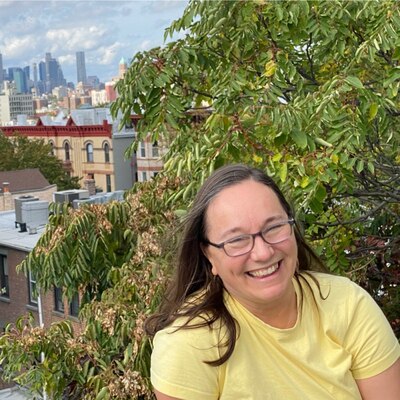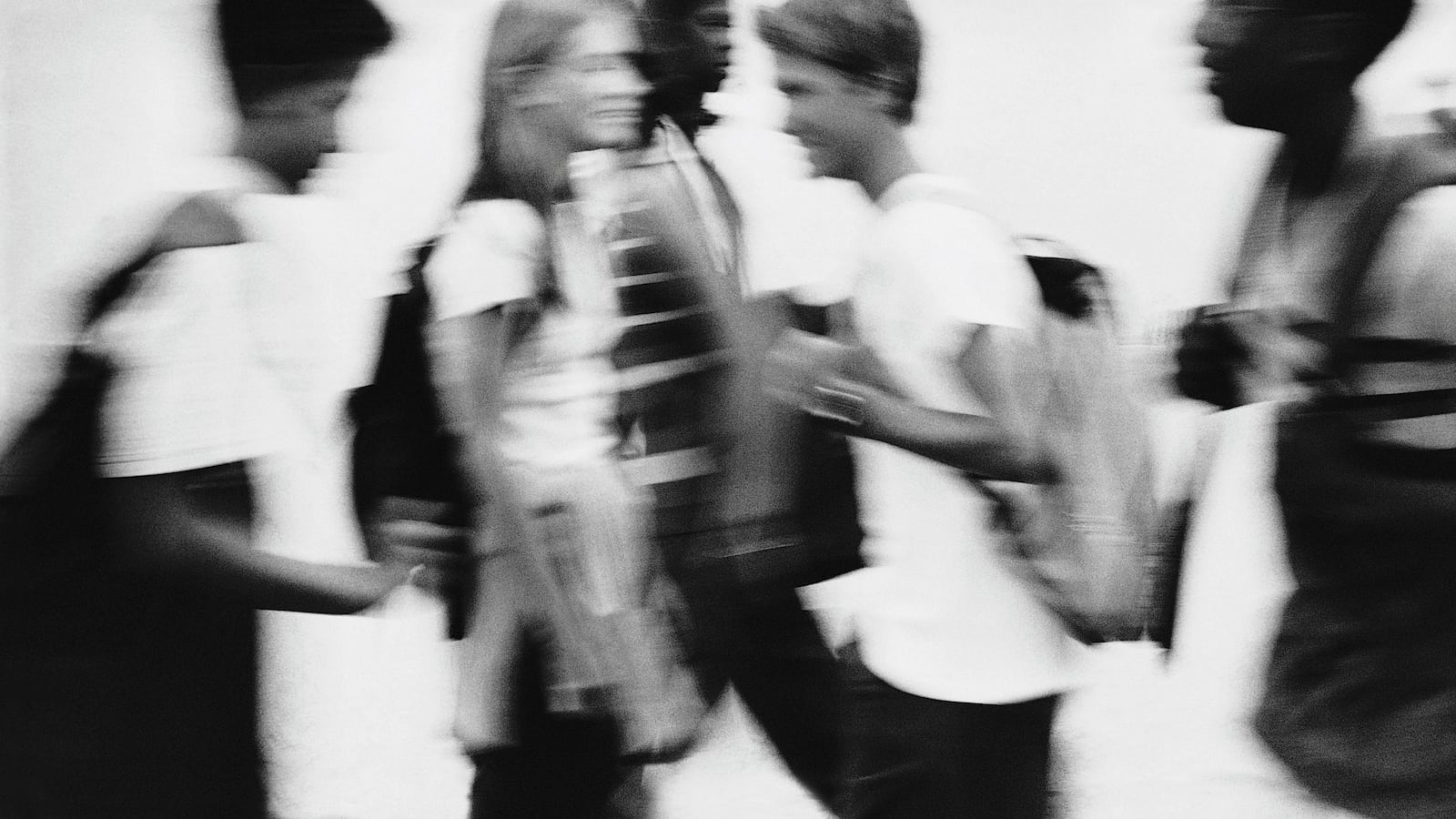Not two months in, we knew our daughter was having a rough transition to high school. The pre-dawn sobbing in the kitchen, as she begged to sleep just a little longer. The mornings she never got out of bed or to school at all. The nightly throwdowns to not only wrestle homework but figure out what it even was. (“Physics notebook” means what now?) The student portal bleeding red from missed assignments.
Still, I was unprepared for what awaited me at student-led conferences at the famously rigorous specialized high school she was attending. Conference duty fell to me while my husband stayed home with our son. Capitalizing on a lovely fall day, I biked off across Brooklyn to one of the worst experiences of my parenting life.

At student-led conferences, kids are supposed to present work and reflect on their progress. However, my daughter mostly sat mute beside me as teacher after teacher after teacher said a version of the same thing: She’s way behind on her assignments. She stares off into space and doesn’t participate. Sometimes, she doesn’t even take off her backpack. They described an almost catatonic kid who wasn’t just slipping academically but had forgotten how to do school.
“Why aren’t you taking off your backpack?” I shrieked at her between conferences, displaying truly stellar parenting. My only defense is that I was in shock. She refused to meet my gaze.
After the last conference, my daughter shuffled off to a homework makeup session. I watched her trudge down the hallway, head dropped, shoulders pulled up defensively around her ears, jostled by bigger kids streaming in the opposite direction.
That’s when I ducked into the office of the school social worker. Despite an effusion of teens in the outer office, she had a free moment. I sat down and poured out everything that had just happened at the conferences. What could we do? I pleaded, my emotions raw.
It would have meant the world to have heard something along the lines of, ‘We’ve seen this before. Here’s what we can try.’
“Well,” the social worker said, looking down as she tidied some papers on her desk, “in this school we value self-advocacy. We encourage our students to advocate for themselves.” I stared blankly, left the office, and never bothered with the social worker again. (In fairness, she was the single social worker for multiple schools.)
Ah, good ol’ self-advocacy. I’d heard that Ayn Rand, management-seminar garbage during the conferences, too, and would hear more before this was all over. Look, self-advocacy is great. I value it as well! Unquestionably, young people need to develop some. But not two months into high school, my daughter had fallen off a cliff. I don’t know many 13-year-olds in my daughter’s position who could self-advocate themselves to success.
We had not particularly wanted our daughter to go to one of New York City’s eight specialized high schools for which the only admissions criteria is an entrance exam known as the SHSAT. We knew they could be competitive pressure cookers and would feel very different from the supportive, unscreened middle school she’d loved. We also knew the specialized high schools notoriously do not reflect the racial makeup of the citywide student population. (And the experience isn’t always so great for the few Black and Latino students who do attend. Read their stories here and here.) So why did we apply? I guess, given the city’s anxiety-producing high school application process, and being not completely insusceptible to the mores of our urban white middle-class milieu, we felt that we should at least keep all options open.
And now here we were, having every single one of our misgivings confirmed, and it wasn’t even Halloween.
At those disastrous student-led conferences, a few of the teachers were sympathetic, but not one offered substantive help. I know public schools are starved for support services, but it would have meant the world to have heard something along the lines of, “We’ve seen this before. Here’s what we can try.” Or, “Speak to our special education coordinator about getting an IEP.” Or even, “Check out these books or websites.” Nothing. The message couldn’t have been clearer: Your kid is a wreck, and you’re on your own to fix it.
That day, I biked home in tears. I called my husband, hysterical. I called my sister, incoherent. They held me steady and gave wise counsel: Slow down. Take a breath. The world isn’t ending. Right now, your child needs you. They were right.
Battle stations were manned, and we leapt into action. Neuropsych evaluation: check. ADHD diagnosis: check. Therapist and psychiatrist lined up: check. Meds: check. The financial means and privilege to accomplish all of the above: check, and never do I forget that. IEP secured: after some effort, check. Begin searching for another school: perhaps the biggest check of all. Because before I had even unlocked my bike to head home that day, I vowed that our daughter would not remain in that place. It wasn’t only the early start time and overwhelming workload. In all the ways most important to us, the school did not prioritize the well-being of its students.
I’ll share an example of this tenet taken to ridiculous extremes. Trying to catch our daughter up in physics, one assignment, in particular, stymied us. “Physics notebook,” was all it said in JumpRope, the dreaded student portal. We emailed the teacher to ask what “physics notebook” meant. His answer: “All the assignments are in JumpRope.” Yes, we said, but we don’t know what it means. “Ask your daughter.” She didn’t know either. “Then she’ll have to find out some other way.” What the actual fu- OK, OK. She asked some students. They didn’t know (a sign that our daughter wasn’t the only one struggling and that the teacher’s methods were not the slam dunk he thought they were). Again we tried. Again we heard: “Your daughter has to learn how to advocate for herself.”
This madness went on for no less than 10 rounds of email. One I cannot forget or forgive: “Every other student in the class has successfully completed that assignment. Your daughter is the only one who hasn’t.” Even if that were true — which, I discovered later, it totally was not — what kind of an educator says something like that about a struggling student? Finally, the teacher, in his kindness and mercy, revealed that “physics notebook” meant — pay attention now, this is complicated — showing him that she had a notebook for the class. Like, literally, waving a Mead spiral-bound and saying, “here.”
A school that sits stone-faced when students flail is a school that does not care about their well-being. I say this with conviction because I’ve seen what the opposite looks like. At the school she transferred to the following fall, Essex Street Academy (and no more beautiful school was there ever), she was never left to twist in the wind about a simple assignment. Every day, the staff demonstrated their commitment to doing what’s best for students. Immediate evidence of this: They start school at 9:25 a.m., having taken to heart the vast body of research showing that teenage brains do not function at the crack of dawn. Essex has open admissions, which is no coincidence. A non-selective mindset, I’ve found, usually goes hand-in-hand with a strong focus on students’ well-being. I wish more parents recognized that.
My daughter still had challenges; that’s simply a fact of life with ADHD. But when she fell behind, her teachers and counselors helped her, almost as though they understood that supporting kids was the job of educators or something. I don’t remember one morning when she resisted going to school. It was an engaging, robust curriculum — not a crushing workload — that spurred her critical thinking and broadened her worldview. Under the tutelage of her glorious college counselor, she applied (with zero assistance from Mom and Dad) to several colleges, and got accepted at four. Last spring, she graduated. Deferring college for a year, she landed her first job, at a big-box retail store, and then a better-paying one scooping ice cream. She’s headed to college in the fall and plans to study marine biology.
All of this she did through her own, dare I say, self-advocacy.
Now a few years out, my daughter reflects on her freshman year with the clarity of distance. Her memories aren’t all bad. She generally liked the kids and remembers a few teachers fondly. The lasting impression, though, is of a place that pretty much gave up on her.
My daughter, I’m sure, is far from the only kid who ever arrived at a specialized high school and discovered that it was the wrong place for them. I wonder how many stick it out for four miserable years because they and their families are convinced that these are the “best” schools in the city. Or that if something’s amiss, it must be the kid who didn’t measure up. Or that it’s impossible to get a good education anywhere else. I am here to say emphatically that it is possible. It may even be preferable; it was for us. And like model students, we’ve applied the lessons learned: Our son, an eighth grader this year, did not take the SHSAT.
Mary Jean Babic, a proud New York City public school parent, lives in Brooklyn and works as a user experience writer in the financial industry.


